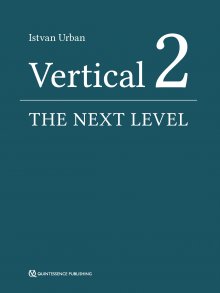Istvan Urban - Vertical 2: The Next Level of Hard and Soft Tissue Augmentation

Скачивание начинается... Если скачивание не началось автоматически, пожалуйста нажмите на эту ссылку.
Жалоба
Напишите нам, и мы в срочном порядке примем меры.
Описание книги "Vertical 2: The Next Level of Hard and Soft Tissue Augmentation"
Описание и краткое содержание "Vertical 2: The Next Level of Hard and Soft Tissue Augmentation" читать бесплатно онлайн.
A major part of this book comprises full-color, step-by-step images of patient cases. At times, reading it is like watching a surgical video, where the author 'stops the video' to discuss with you, the reader, what he is thinking and doing at that step, what his next step will be, and the reason for it.
Included again are the well-appreciated 'Lessons learned' sections, where the learning objectives are emphasized and further notes given, including ways to further improve the techniques. The section on the mandible is more detailed in this book, with the focus on larger defects and the different surgical steps in native, fibrotic, and scarred tissue types around the mental nerve during flap advancement.
In addition, light is shed on the detail in treating the anterior maxilla, which has not been published previously. It includes treatment options such as the fast track, the safe track, and the technical track of soft tissue reconstruction in conjunction with bone grafting as well as papilla reconstructions after bone regeneration. The section on the posterior maxilla hopes to resolve issues such as the management and complications of combined ridge and sinus grafting, including difficulties such as the lack of buccal, crestal or nasal bony walls of the posterior maxilla before bone grafting.
In this must-have new publication, the procedures are kept simple, repeatable, and biologically sound. The techniques presented are not overcomplicated; they are simple treatment strategies with lower complication rates and more predictability in the final outcome.
Bone gain analysis
Table 2-2 and Figure 2-2a and b document ridge height changes post-VBA.
The mean baseline vertical deficiency was 5.5 ± 2.6 mm. The absolute gain in vertical dimension from VBA was 5.2 ± 2.4 mm, corresponding to a mean relative height gain of 96.5 ± 13.9%; 89.2% of the sites presented complete regeneration, i.e. elimination of vertical deficiency. Each 1-month addition to the healing time increased the relative gain by 1.34%.
Table 2-1 Demographic and clinical characteristics of the studied cohort
N (%) / mean ± SD Patient Level N patients 57 Age (years) 51.9 ± 11.8 Gender Male 21 (36.8) Female 36 (63.2) Smoker No 55 (96.5) Yes 2 (3.5) N sites on surgery 1 49 (86.0) 2 8 (14.0) Site level N sites 65 Site Maxillary anterior 12 (18.5) Maxillary right posterior 11 (16.9) Maxillary left posterior 6 (9.2) Mandibular anterior 4 (6.2) Mandibular right posterior 15 (23.1) Mandibular left posterior 17 (26.2) N implants 0 3 (4.6) 1 7 (10.8) 2 34 (52.3) 3 20 (30.8) 4 1 (1.5) Healing time (months) 9.7 ± 3.3 Complications None 63 (97) Exposure 1 (1.5) Infection 1 (1.5) Defect type Vertical 65 (100) Defect size (mm) 5.5 ± 2.6 N missing teeth 3.2 ± 1.2 Maxilla 3.1 ± 1.5 Mandible 3.2 ± 0.9 N: number (of patients or sites as a percentage); SD: standard deviationTable 2-2 Changes in the dimensional parameters of the defects after bone augmentation
Vertical 5.5 ± 2.6 5.2 ± 2.4 96.5 ± 13.9 89.2Table 2-3 Multiple linear regression analysis on the relative vertical gain (%) controlling for defect size, arch, healing time, and age
Regression coefficient 95% CI P value Defect size < 0.001*** < 5 mm (reference) 0.00 5–8 mm –5.97 -11.8 to 0.13 0.045* > 8 mm –11.9 -17.8 to 5.89 < 0.001*** Arch Maxilla (reference) 0.00 Mandible –2.98 -8.01 to 2.05 0.246 Healing time 1.34 0.08 to 2.60 0.037* Age 0.08 -0.05 to 0.21 0.207 CI: confidence interval *P < 0.5 ***P < 0.001Influence of baseline vertical deficiency on absolute and relative bone gain
Six defects out of 65 were not completely regenerated. Five of these sites had baseline vertical deficiencies of ≥ 10 mm (Fig 2-3a), and one site with a 6-mm baseline deficiency was infected postoperatively. The probability of achieving complete regeneration was inversely proportional to defect size (P = 0.005). Each 1-mm addition to baseline height deficiency increased the likelihood of incomplete bone regeneration by 2.5 times. Having a baseline deficiency of 5 to 8 mm reduced the relative gain by 6% compared with having a baseline deficiency of < 5 mm (P = 0.045). Having a baseline deficiency of > 8 mm reduced the relative bone gain by 12% compared with having a baseline deficiency < 5 mm (P < 0.001) (Fig 2-3b). Multiple linear regression controlling for defect size, arch, healing time, and age (Table 2-3 (identified healing time to be a significant factor affecting vertical growth (P = 0.037).
Fig 2-2 (a) Correlation between defect size and vertical gain. The red dots represent cases that were not completely regenerated; five such cases had baseline vertical deficiencies measuring ≥ 10 mm. One defect with a base-line deficiency of 6 mm showed a null gain. (b) Relative vertical gain according to baseline deficiency (SD = standard deviation).
Fig 2-3 Absolute and relative vertical gain in the (a) maxilla, and (b) mandible (SD = standard deviation).
Influence of defect location on absolute bone gain: maxilla vs mandible
There were 29 maxillary and 36 mandibular defects treated in our study. The baseline mean vertical deficiency was 5.3 ± 2.5 mm in the maxilla and 5.6 ± 2.7 mm in the mandible; there was no difference in this variable between the arches per GEE (P = 0.664). Mean absolute vertical bone gain was 5.1 ± 2.2 mm in the maxilla and 5.3 ± 2.6 mm in the mandible; there was no difference in this variable between the arches per multiple linear regression (P = 0.596) (Table 2-4). Defect size (P < 0.01) and healing time (P < 0.05) significantly affected vertical gain. Smoking was not statistically relevant (P = 0.220), but a large effect size (beta = 1.60) was observed.
Table 2-4 Multiple linear regression analysis on the absolute vertical gain by sector controlling for defect size, arch, healing time, smoking, and age
Influence of defect location on absolute bone gain: anterior vs posterior
Out of the 29 maxillary vertical defects, 12 were anterior and 17 were posterior. The mean baseline vertical deficiency was 5.7 ± 2.7 mm anteriorly and 5.1 ± 2.4 mm posteriorly; these values were not statistically different (P = 0.489). The mean absolute vertical gain was statistically higher in posterior sites than anterior ones by 0.36 mm (P = 0.048) (see Table 2-4). The extent of the baseline vertical deficiency (P < 0.01) and smoking (P < 0.05) significantly affected maxillary absolute gain (see Table 2-4).
Out of 36 vertical defects, 4 were anterior and 32 were posterior. The mean vertical deficiency was 5.3 ± 1.0 mm anteriorly and 5.6 ± 2.9 posteriorly; these values were not statistically different (P = 0.540). The mean absolute vertical bone gain was significantly greater in the anterior sites than the posterior ones by 0.32 mm (P = 0.021) (see Table 2-4). The extent of the baseline vertical deficiency and smoking significantly affected mandibular absolute gain.
Influence of defect location on absolute and relative bone gain: anterior vs left posterior vs right posterior
In the maxilla, there were 12 anterior, 11 right posterior, and 6 left posterior defects. The mean vertical deficiency was 5.5 ± 2.9 mm on the right posterior side and 4.3 ± 0.8 on the left posterior side. There were no differences in absolute bone gain between maxillary left and right posterior sides per multiple linear regression (P = 0.726). Maxillary anterior defects showed less bone gain compared with left and right posterior defects (P = 0.05) (see Table 2-4 and Fig 2-3a).
In the mandible, there were 4 anterior, 15 right posterior, and 17 left posterior defects. The mean vertical defect size was 5.8 ± 3.2 mm on the right posterior side and 5.5 ± 2.6 on the left posterior side, with no significant differences between the sides (P = 0.72). A statistically significant difference in vertical bone gain was detected between the mandibular anterior, left posterior, and right posterior areas (P = 0.028) (see Table 2-4 and Fig 2-3b). The relative vertical gain was 98.3% for mandibular left posterior sites and 90.9% for right posterior sites (0.3 mm of absolute gain difference).
Postsurgical complications
There were only two cases (3%) with complications. One site presented membrane exposure (1-week postoperatively), and the graft material became infected at a second site. For the first case, the exposed membrane was maintained for 2 months and then removed. For the second case, the infected membrane and graft were explored and removed after 10 days of healing.
Подписывайтесь на наши страницы в социальных сетях.
Будьте в курсе последних книжных новинок, комментируйте, обсуждайте. Мы ждём Вас!
Похожие книги на "Vertical 2: The Next Level of Hard and Soft Tissue Augmentation"
Книги похожие на "Vertical 2: The Next Level of Hard and Soft Tissue Augmentation" читать онлайн или скачать бесплатно полные версии.
Мы рекомендуем Вам зарегистрироваться либо войти на сайт под своим именем.
Отзывы о "Istvan Urban - Vertical 2: The Next Level of Hard and Soft Tissue Augmentation"
Отзывы читателей о книге "Vertical 2: The Next Level of Hard and Soft Tissue Augmentation", комментарии и мнения людей о произведении.




















